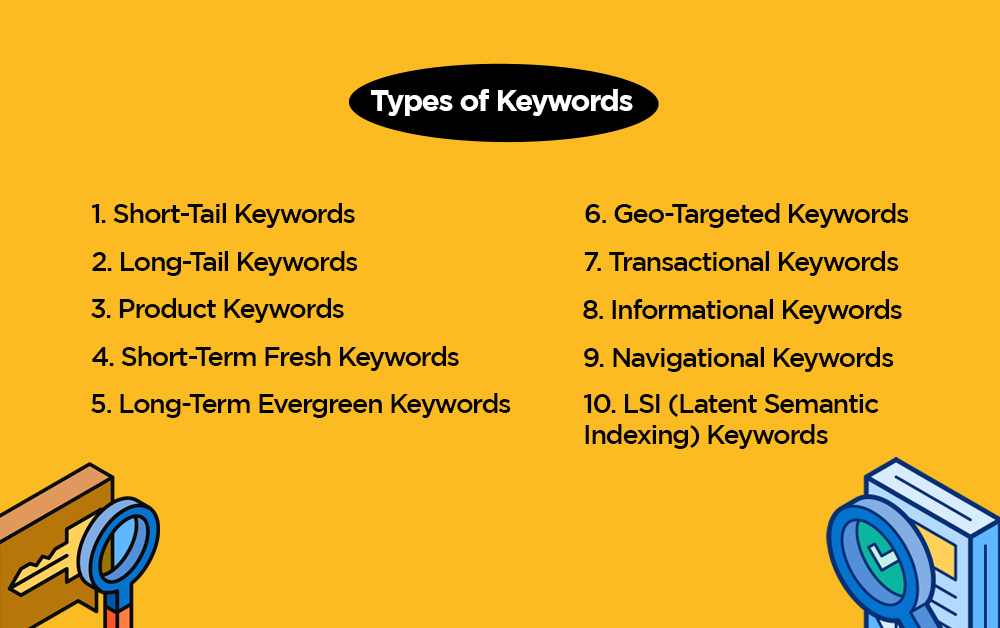
Ever wondered how people discover your website in the vast expanse of the internet? It all begins with keywords – those small phrases that act like a secret code to unlock your content on search engines. Identifying different types of keywords is crucial for optimizing SEO and marketing efforts. Keywords serve as the bridge connecting search engine queries to relevant content on your website. Using the right types of keywords in SEO can significantly enhance your website’s visibility and drive targeted traffic.
Keywords are the backbone of search engine optimization (SEO) and digital marketing, linking what people search for with the content you provide. Understanding the various types of keywords is crucial for a successful SEO strategy, enabling you to target your audience effectively and improve your search engine rankings. In this comprehensive guide, we’ll examine various types of keywords, keyword research, and their roles in SEO and digital marketing. We’ll explain why they are crucial for driving traffic to your website.
Table of Contents
What are Keywords?

Keywords are specific terms that capture the main idea of a piece of content. In digital marketing, keywords are essential because they help search engines like Google understand the content and its relevance to user searches. By strategically using relevant keywords, businesses can improve their search engine rankings, making it easier for potential customers to find them online.
For example, a bakery might use keywords like “fresh bread,” “artisan pastries,” and “local bakery” in their website content. When someone searches for these terms, the bakery’s website is more likely to appear in the search results. This targeted approach increases the likelihood of attracting customers specifically looking for what the bakery offers.
Keywords are important because of their ability to drive organic traffic, enhance visibility, and improve conversion rates. Effective keyword usage involves researching popular search terms and incorporating them naturally into content, ensuring that it meets both search engine criteria and user intent.
The Art and Science of Keyword Research
Keyword research is essential for SEO and internet marketing as it helps identify the types of keywords potential customers use in searches. By targeting these keywords, businesses can attract qualified traffic, enhance visibility, and improve conversion rates. It ensures content aligns with user intent, increasing the chances of higher rankings in search engine results pages (SERPs). Mastering the different types of keywords in SEO is key to devising effective strategies. Without proper keyword research, even high-quality content may go unnoticed, leading to missed engagement and sales opportunities.
Tools for Keyword Research

Tools like Google Keyword Planner, Ahrefs, and SEMrush are invaluable for keyword research.
Google Keyword Planner offers data on search volume, competition, and bid estimates.
Ahrefs provides insights into keyword difficulty, search volume, and click-through rates.
SEMrush delivers comprehensive keyword analysis, competitive research, and trend reports.
These tools help uncover valuable keywords, understand their competitiveness, and gauge their traffic-driving potential, ensuring a data-driven keyword strategy.
How to Analyze Keyword Difficulty & Search Volume
Analyzing keyword difficulty and search volume is crucial for selecting effective keywords. Keyword difficulty measures the difficulty of ranking for a keyword, with higher scores indicating more competition. Search volume indicates the average monthly searches for a keyword. Balancing these factors is key; targeting a mix of high and low-competition keywords can achieve both immediate and long-term SEO success. Tools like Ahrefs and SEMrush provide these metrics, guiding informed keyword choices.

Types of Keywords

1. Short-Tail Keywords
Short-tail keywords, also known as head terms, are usually one to two words long. They are broad and generic, making them highly competitive. For example, “shoes” is a short-tail keyword. While these keywords can drive a lot of traffic to your site, ranking for them can be challenging due to the high competition.
Advantages:
- High search volume
- Broad reach
Disadvantages:
- High competition
- Low conversion rate
2. Long-Tail Keywords
Long-tail keywords are specific and detailed terms that people search for online. They’re usually longer and more precise than common keywords. Even though fewer people search for them, they often lead to more successful results because they match exactly what someone is looking for. Examples include “best-running shoes for flat feet” or “easy vegan recipes for beginners.”
Advantages:
- Lower competition
- Higher conversion rate
Disadvantages:
- Lower search volume
- More specific audience
3. Short-Term Fresh Keywords
Short-term fresh keywords are trending keywords that have a temporary spike in search volume. These types of keywords in digital marketing are relevant for a short period and can help attract immediate traffic. Specifically, “Olympics 2024” or “latest iPhone release.” Targeting short-term fresh keywords can help capture traffic during peak interest periods.
Advantages:
- High search volume during the trend
- Immediate traffic boost
Disadvantages:
- Short-term relevance
- Requires constant updating
4. Long-Term Evergreen Keywords
Long-term evergreen keywords stay relevant for extended periods, attracting traffic to your site long after content is posted. Examples like “how to tie a tie” or “benefits of drinking water” illustrate their enduring appeal, offering consistent traffic and value to your website strategy.
Advantages:
- Long-lasting traffic
- Consistent relevance
Disadvantages:
- May require regular updates to maintain rankings
- Moderate competition
5. Product Keywords
Product keywords are specific to a particular product or service you offer. These keywords are often used by users who are ready to make a purchase. For example, “Nike Air Max 270” is a product keyword. By targeting product keywords, you can attract users who are looking for specific items, increasing the likelihood of conversion.
Advantages:
- High conversion rate
- Targeted audience
Disadvantages:
- Can be highly competitive
- Requires specific content
6. Geo-Targeted Keywords
Geo-targeted keywords attract local visitors and are crucial for businesses operating in specific areas or with physical locations. Such as, “best pizza in New York” is a geo-targeted keyword. Optimizing your content with geo-targeted keywords can help you rank higher in local search results and attract customers in your vicinity.
Advantages:
- Attracts local traffic
- Lower competition in specific regions
Disadvantages:
- Limited reach to the local audience
- May require multiple variations for different locations
7. LSI (Latent Semantic Indexing) Keywords
LSI keywords are related to the primary keyword and help search engines understand the context of the content. For example, if your primary keyword is “apple,” LSI keywords could include “fruit,” “orchard,” and “recipes.”
Advantages:
- Enhances content relevance
- Improves SEO by providing context
Disadvantages:
- Requires thorough research
- Not always straightforward to identify
8. Transactional Keywords
Transactional keywords indicate a strong intent to make a purchase or complete a transaction. These keywords often include terms like “buy,” “order,” “discount,” or “coupon.” For example, “buy iPhone 12 online” is a transactional keyword. Targeting these types of keywords can drive high-converting traffic to your site.
Advantages:
- High conversion rate
- Clear user intent
Disadvantages:
- High competition
- Requires compelling content and CTAs
9. Informational Keywords
Informational keywords are used by users seeking information or answers to their questions, often starting with terms like “how,” “what,” “why,” or “best.” For example, “how to train a dog” is an informational keyword. Creating content that addresses these queries can help establish your site as an authority in your niche and attract a broader audience.
Advantages:
- Attracts a wide audience
- Establishes authority and trust
Disadvantages:
- Lower conversion rate
- Requires comprehensive and valuable content
10. Navigational Keywords
Navigational keywords are used when users are looking for a specific website or page. Like, “Facebook login” or “YouTube” are navigational keywords. Ensuring that your site ranks for navigational keywords can help direct users to the correct page quickly.
Advantages:
- Directs traffic to specific sites
- High user intent
Disadvantages:
- Limited to known brands or websites
- Low competition
How to Choose the Right Keywords

Choosing the right keywords involves understanding your audience, analyzing keyword metrics, and aligning your choices with your business goals. Here are some tips to help you select the best keywords for your SEO strategy:
- Target Audience Insight: Recognize your target audience and their search preferences. Develop buyer personas to gain insight into your ideal customer.
- Use Keyword Research Tools: Tools like Google Keyword Planner, SEMrush, and Ahrefs can help you find relevant keywords and analyze their search volume, competition, and potential traffic.
- Analyze Keyword Metrics: Consider metrics such as search volume, competition, and keyword difficulty. While high search volume keywords can boost traffic, they often face more competition. Choose different types of keywords that bring both visitors and have moderate competition for better results.
- User Intent Analysis: Reflect on the purpose behind search queries. Determine if users seek information, products, or services. Align your keywords with user intent to enhance relevance.
- Use a Mix of Keywords: Use various keyword types in your strategy, like short-tail, long-tail, exact match, and phrase match. This approach helps you target specific searches and reach a wider audience.
Utilizing Keywords in SEO & Digital Marketing

1. On-Page SEO (Titles, Meta Descriptions, Headers, Content)
On-page SEO optimizes individual web pages to rank higher and attract relevant traffic. It involves placing keywords in titles, meta descriptions, headers, and content. Compelling titles with primary keywords capture attention. Meta descriptions, though not ranking factors, influence click-through rates by summarizing content. Headers structure content and should include keywords for readability and SEO. Naturally integrating keywords into the content ensures it is informative and engaging, and signals search engines about the page’s topic.
2. Off-Page SEO (Backlinks, Social Signals)
Off-page SEO improves site authority and ranking through activities like getting quality backlinks from reputable sites, which act as endorsements. Social signals like likes, shares, and comments on social media platforms drive traffic and indirectly influence rankings by enhancing visibility. Effective off-page SEO involves building relationships with influencers, creating shareable content, and engaging consistently on various platforms to boost website authority and search engine rankings.
3. Content Marketing (Blog Posts, Articles, Infographics)
Content marketing creates and shares valuable content to attract and retain a defined audience. Blog posts, articles, and infographics are effective formats that utilize keywords for SEO. Blog posts and articles allow for detailed exploration of topics and targeting long-tail keywords. Infographics present information visually, making it shareable and easy to understand, attracting backlinks and social shares. Integrating keywords naturally ensures the content is valuable for readers and boosts search engine rankings.
4. PPC Campaigns (Google Ads, Social Media Ads)
PPC campaigns involve paying for ads on search engines and social media. Google Ads and social media ads like Facebook and Instagram allow precise keyword targeting to reach the right audience. Effective keyword selection maximizes ROI by ensuring ads appear in relevant searches, attracting potential customers. Regularly monitoring and adjusting keyword bids, ad copy, and targeting parameters optimize campaign performance, ensuring cost-effective results and better engagement with the target audience.
5. Tracking and Measuring Keyword Performance (Using Tools Like Google Analytics, and Search Console)
Tracking and measuring keyword performance is vital for understanding SEO and online marketing effectiveness. Tools like Google Analytics and Google Search Console provide data on keyword rankings, traffic, and user behaviour. Google Analytics tracks visitor interactions and identifies top-performing keywords. Google Search Console offers insights into rankings, click-through rates, and impressions. Regular analysis of this data helps refine strategies, optimize content, and ensure continuous improvement in keyword campaigns for sustained success.

Summing Up
Keywords are essential in SEO and digital marketing as they link search queries to your content. Understanding and using different types of keywords, such as short-tail, long-tail, transactional, and geo-targeted keywords, can significantly boost your website’s visibility and attract targeted traffic.
Effective keyword research and analysis using tools like Google Keyword Planner, Ahrefs, and SEMrush are essential for finding valuable keywords. Using these keywords in your on-page and off-page SEO, content marketing, and PPC campaigns ensures a clear strategy that meets what users are searching for.
Thus, tracking and measuring keyword performance with tools like Google Analytics and Search Console helps refine your strategy for continuous improvement. By mastering keyword usage, one can improve their search engine rankings and create a more engaging online presence, driving the success of their SEO and online marketing efforts.



